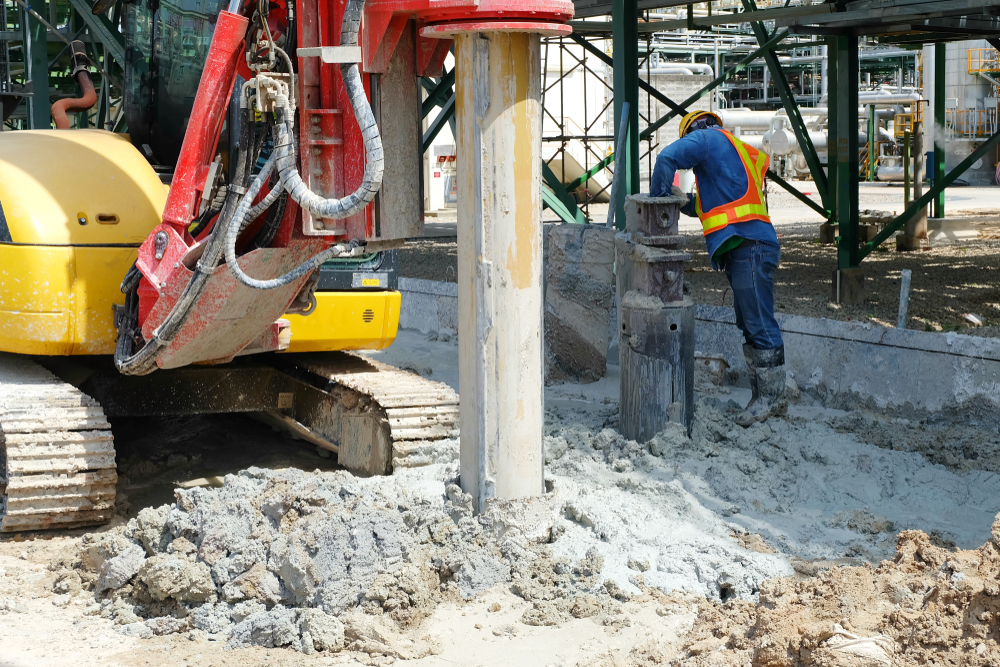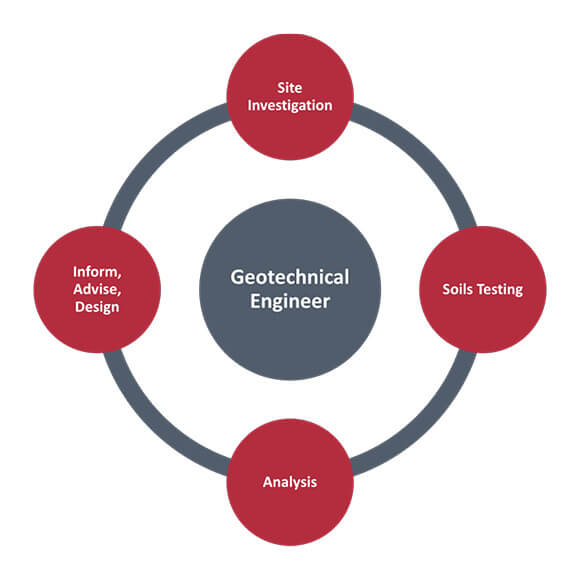Geotechnical Engineering For Construction Projects for Dummies
What Does Geotechnical Engineering For Construction Projects Mean?
Table of ContentsThe Single Strategy To Use For Geotechnical Engineering For Construction ProjectsSome Of Geotechnical Engineering For Construction ProjectsA Biased View of Geotechnical Engineering For Construction ProjectsSome Of Geotechnical Engineering For Construction ProjectsHow Geotechnical Engineering For Construction Projects can Save You Time, Stress, and Money.The 25-Second Trick For Geotechnical Engineering For Construction ProjectsGeotechnical Engineering For Construction Projects - Questions
and Kovacs, W. (1981 ), An Introduction to Geotechnical Engineering, Prentice-Hall, Inc. Deep Check Technology (2023 ): Deep Check Tech reveals surprise structures at the website of Denmark's tallest structure. "Geofrost Coring". GEOFROST. Obtained 20 November 2020. Han, Jie (2015 ). Concepts and Technique of Ground Enhancement. Wiley. ISBN 9781118421307. RAJU, V. R.Ground Renovation Technologies and Case Histories. Singapore: Research Study Publishing Solutions. p. 809. ISBN978-981-08-3124-0. Ground Enhancement Concepts And Applications In Asia. Pariseau, William G. (2011 ). Design evaluation in rock auto mechanics. CRC Press. Hegde, A.M. and Palsule P (Geotechnical Engineering for Construction Projects).S. (2020 ), Performance of Geosynthetics Reinforced Subgrade Subjected to Repetitive Lorry Loads: Speculative and Mathematical Researches.
Cengage Learning, Stamford, 666 p. Atkinson, J., 2007. The technicians of soils and structures. The Observational Method in ground design principles and applications.
About Geotechnical Engineering For Construction Projects
Research laboratory and field testing plays a crucial duty in this process. By removing samples from the planet's subsurface and applying a collection of tests, geotechnical designers can predict the practices of soil layers and review their suitability for different building and construction efforts. The essence of geotechnical design in civil engineering can not be overemphasized, attributable to a number of aspects: The preliminary action in any kind of geotechnical research study involves establishing the soil kind at the building and construction site.
The foundation acts as the bedrock of any type of building project. Picking the appropriate structure type is a decision that pivots on the detailed evaluation supplied by geotechnical engineering.

Geotechnical site investigation is a vital step in the planning and implementation of any building and construction task. It involves the collection and analysis of information connected to the physical buildings of dirt and rock under a recommended building website. This information is crucial for the style and building of safe, stable, and sustainable structures.
Geotechnical Engineering For Construction Projects Things To Know Before You Get This
In this blog site, we will certainly dig into the importance of geotechnical site examination, its various parts, and exactly how it profits building and construction tasks. Geotechnical website investigation, also referred to as subsurface expedition, includes a series of activities focused on determining the dirt, rock, and groundwater conditions at a construction website. The key objectives are to identify prospective geotechnical risks, analyze the design buildings of subsurface products, and offer recommendations for the layout and building of structures, keeping walls, and other frameworks.
This might include geological maps, aerial photographs, previous examination reports, and historical data. The workdesk research helps in identifying prospective geotechnical concerns and planning the succeeding fieldwork. Complying with the workdesk research, a website reconnaissance is carried out to visually inspect the site and its environments. This includes observing the topography, water drainage patterns, existing frameworks, plant life, and any kind of signs of instability or erosion.
Geotechnical Engineering For Construction Projects Fundamentals Explained
Superficial test pits are dug deep into to directly observe and sample the soil and rock. This method is helpful for examining the top layers of the subsurface and recognizing near-surface hazards. Non-invasive geophysical techniques, such as seismic check over here refraction, ground-penetrating radar (GPR), and electrical resistivity tomography (ERT), are utilized to map subsurface problems and discover abnormalities.
Dirt and rock examples gathered throughout the area examination undergo research laboratory screening to determine their physical and mechanical homes. Common research laboratory tests include grain size evaluation, Atterberg limits, compaction examinations, triaxial shear examinations, and debt consolidation examinations. These examinations provide vital data for geotechnical evaluation and layout. The data accumulated from the desk research study, website reconnaissance, field investigation, and lab testing are examined and analyzed to establish a comprehensive understanding of the subsurface conditions.
The key benefit of geotechnical site investigation is making sure the security and security of structures. By recognizing the subsurface problems, engineers can create foundations and various other architectural components that can endure the you could try this out lots and environmental forces they will certainly go through. This lessens the danger of negotiation, decrease, and architectural failure.
The Basic Principles Of Geotechnical Engineering For Construction Projects
This makes sure reliable and safe building practices. Geotechnical website investigations are often required by building codes and laws.
This info is indispensable for project supervisors, architects, and professionals in developing practical schedules, budgets, and backup plans. Geotechnical Engineering for Construction Projects. Skyscraper Building in a Coastal AreaIn a seaside city, a high-rise household structure was intended on a website with thought loosened sand deposits and a high water table. An in-depth geotechnical examination, including borehole exploration, CPT, and geophysical studies, was conducted
Geotechnical Engineering For Construction Projects Things To Know Before You Buy
Based upon these searchings for, the foundation layout was customized to consist of deep stack structures extending right into stable strata, and ground renovation methods, such as vibro-compaction, were executed to alleviate liquefaction threats. This proactive technique made certain the security and security of the structure while staying clear of pricey post-construction removal. Framework Advancement on a Sloping TerrainA major framework job, involving the building and construction of a highway and bridges, was planned on a sloping surface with steep inclines.

The Leaning Tower of Pisa (Italy), an iconic architectural wonder, is infamous for its unintentional tilt from significant geotechnical issues. The tower's foundation was inadequately created to handle the soft, unpredictable soil beneath it, resulting in irregular negotiation and its distinct lean. Our world is populated with remarkable infrastructure projectsfrom looming high-rises to sprawling bridgesall standing statement to the evolution of the numerous building and construction tools and techniques available.
Geotechnical engineering is a customized field within civil design that concentrates on examining the behavior of planet products. This branch digs deep right into the groundinvestigating how the dirt, rock, and groundwater at a construction site can influenceand be affected bythe facilities that we put up on and into them. Before a solitary block is laid or a concrete foundation put, geotechnical engineers probe into the earthgathering critical information regarding the site's dirt structure, rock structure, and groundwater degrees.
A Biased View of Geotechnical Engineering For Construction Projects

is a tool utilized to examine the stability and load-bearing capacity of heaps during setup, leveraging the principle of wave breeding. It maximizes building performance by providing real-time evaluations, therefore making sure secure and effective heap structures. Among the practical applications of geotechnical design entails determining and carrying out the ideal methods for foundation building and construction.
Stack driving stands for more than the plain act of inserting structural components right into the ground. As a matter of fact, it is a meticulously orchestrated procedure of transferring a framework's tons past the less steady soil layers closer to the surfacedown to the much more significant strata that lie below. In the instance of pile driving, consider just how geotechnical designers skillfully utilize this method to evenly disperse the structure's weight.